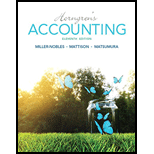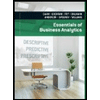
Horngren's Accounting (11th Edition)
11th Edition
ISBN: 9780133856781
Author: Tracie L. Miller-Nobles, Brenda L. Mattison, Ella Mae Matsumura
Publisher: PEARSON
expand_more
expand_more
format_list_bulleted
Concept explainers
Textbook Question
Chapter 26, Problem 8QC
The
Learning Objective 4
- the interest rate at which the
NPV of the investment is zero. - the firm's hurdle rate.
- the same as the ARR.
- None of the above
Expert Solution & Answer
Want to see the full answer?
Check out a sample textbook solution
Students have asked these similar questions
What is the percentage return on these financial accounting question?
Please given step by step explanation general Accounting question
Larkspur Manufacturing Company observed that, during its busiest month of 2022, maintenance costs totaled $18,500, resulting from the production of 40,000 units. During its slowest month, $13,000 in maintenance costs were incurred, resulting from the production of 25,000 units. Use the high-low method to estimate the maintenance cost that the company will incur if it produces 30,000 units. (Calculation in 2 decimal)
Chapter 26 Solutions
Horngren's Accounting (11th Edition)
Ch. 26 - Prob. 1QCCh. 26 - Prob. 2QCCh. 26 - Prob. 3QCCh. 26 - Prob. 4QCCh. 26 - Prob. 5QCCh. 26 - Prob. 6QCCh. 26 - Prob. 7QCCh. 26 - The IRR is Learning Objective 4 the interest rate...Ch. 26 - Prob. 9QCCh. 26 - Ian Corp, is considering two expansion projects....
Ch. 26 - Prob. 1RQCh. 26 - Describe the capital budgeting process.Ch. 26 - Prob. 3RQCh. 26 - Prob. 4RQCh. 26 - Prob. 5RQCh. 26 - Prob. 6RQCh. 26 - What is the payback method of analyzing capital...Ch. 26 - Prob. 8RQCh. 26 - Prob. 9RQCh. 26 - What is the decision rule for payback?Ch. 26 - Prob. 11RQCh. 26 - What is the accounting rate of return?Ch. 26 - How is ARR calculated?Ch. 26 - Prob. 14RQCh. 26 - Prob. 15RQCh. 26 - What is an annuity? How does it differ from a lump...Ch. 26 - Prob. 17RQCh. 26 - Prob. 18RQCh. 26 - Prob. 19RQCh. 26 - Prob. 20RQCh. 26 - Prob. 21RQCh. 26 - Prob. 22RQCh. 26 - Prob. 23RQCh. 26 - Prob. 24RQCh. 26 - Prob. 25RQCh. 26 - Prob. 26RQCh. 26 - Prob. 27RQCh. 26 - Prob. 28RQCh. 26 - Prob. 29RQCh. 26 - Prob. 30RQCh. 26 - Prob. S26.1SECh. 26 - Prob. S26.2SECh. 26 - Prob. S26.3SECh. 26 - Prob. S26.4SECh. 26 - Prob. S26.5SECh. 26 - Prob. S26.6SECh. 26 - Prob. S26.7SECh. 26 - Prob. S26.8SECh. 26 - Prob. S26.9SECh. 26 - Prob. S26.10SECh. 26 - Prob. S26.11SECh. 26 - Prob. S26.12SECh. 26 - Prob. S26.13SECh. 26 - Prob. S26.14SECh. 26 - Prob. E26.15ECh. 26 - Prob. E26.16ECh. 26 - Prob. E26.17ECh. 26 - Prob. E26.18ECh. 26 - Prob. E26.19ECh. 26 - Using ARE to make capital investment decisions...Ch. 26 - Prob. E26.21ECh. 26 - Prob. E26.22ECh. 26 - Prob. E26.23ECh. 26 - Prob. E26.24ECh. 26 - Prob. E26.25ECh. 26 - Prob. E26.26ECh. 26 - Prob. E26.27ECh. 26 - Prob. E26.28ECh. 26 - Prob. P26.29APGACh. 26 - Prob. P26.30APGACh. 26 - Using payback, ARR, and NPVwith unequal cash flows...Ch. 26 - Prob. P26.32APGACh. 26 - Prob. P26.33APGACh. 26 - Prob. P26.34BPGBCh. 26 - Prob. P26.35BPGBCh. 26 - Using payback, ARR, and NPV with unequal cash...Ch. 26 - Prob. P26.37BPGBCh. 26 - Prob. P26.38CPCh. 26 - Prob. 1CPCh. 26 - Prob. 2CPCh. 26 - Prob. 3CPCh. 26 - Prob. 4CPCh. 26 - Prob. 26.1EICh. 26 - Prob. 26.1FC
Knowledge Booster
Learn more about
Need a deep-dive on the concept behind this application? Look no further. Learn more about this topic, accounting and related others by exploring similar questions and additional content below.Similar questions
- I not need ai solution please given correct answer general Accounting questionarrow_forwardThe Blue Jay Corporation has annual sales of $5,200, total debt of $1,500, total equity of $2,800, and a profit margin of 8 percent. What is the return on assets? Provide Right Answerarrow_forwardI want to this question answer general accountingarrow_forward
- What cost does cosmo manufacturing record for the new machine?arrow_forwardFinancial Accounting 5.8: Firm X and Firm Y have debt-total asset ratios of 40% and 30% and returns on total assets of 9% and 11%, respectively. What is the return on equity for Firm X and Firm Y?arrow_forwardI need this question answer general Accounting questionarrow_forward
- Bella's Florist purchased a delivery truck for $25,000. The company was given a $3,000 cash discount by the dealer and paid $1,200 sales tax. Annual insurance on the truck is $600. As a result of the purchase, by how much will Bella's Florist increase its truck account?arrow_forwardcompute the cash conversion cycle for both years.arrow_forwardAnswer? ? Financial accounting questionarrow_forward
arrow_back_ios
SEE MORE QUESTIONS
arrow_forward_ios
Recommended textbooks for you
- Principles of Accounting Volume 2AccountingISBN:9781947172609Author:OpenStaxPublisher:OpenStax College
 Essentials Of Business AnalyticsStatisticsISBN:9781285187273Author:Camm, Jeff.Publisher:Cengage Learning,
Essentials Of Business AnalyticsStatisticsISBN:9781285187273Author:Camm, Jeff.Publisher:Cengage Learning,

Principles of Accounting Volume 2
Accounting
ISBN:9781947172609
Author:OpenStax
Publisher:OpenStax College

Essentials Of Business Analytics
Statistics
ISBN:9781285187273
Author:Camm, Jeff.
Publisher:Cengage Learning,
Capital Budgeting Introduction & Calculations Step-by-Step -PV, FV, NPV, IRR, Payback, Simple R of R; Author: Accounting Step by Step;https://www.youtube.com/watch?v=hyBw-NnAkHY;License: Standard Youtube License